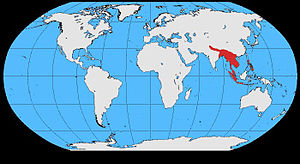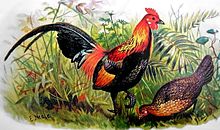Red junglefowl: Difference between revisions
BOT--Reverting link addition(s) by 98.155.72.153 to revision 387872016 (http://tommyspetparadise.webs.com/vietnameserjf.htm) |
|||
| Line 71: | Line 71: | ||
* [http://www.redlist.org/search/details.php?species=47071 IUCN Red List] |
* [http://www.redlist.org/search/details.php?species=47071 IUCN Red List] |
||
* [http://www.wildfowl.uconn.edu/ Reference guide to the four species of the genus Gallus, commonly known as junglefowl. Contains information and photographs of the each of the species] |
* [http://www.wildfowl.uconn.edu/ Reference guide to the four species of the genus Gallus, commonly known as junglefowl. Contains information and photographs of the each of the species] |
||
* [http://tommyspetparadise.webs.com/sandiegozoorjf.htm] |
|||
*{{eol|1049263}} |
*{{eol|1049263}} |
||
Revision as of 07:59, 1 October 2010
| Red Junglefowl | |
|---|---|

| |
| A male (left) and two females at Kaziranga National Park, Assam, India | |
| Scientific classification | |
| Kingdom: | |
| Phylum: | |
| Class: | |
| Order: | |
| Family: | |
| Genus: | |
| Species: | G. gallus
|
| Binomial name | |
| Gallus gallus (Linnaeus, 1758)
| |

| |
| Red Junglefowl range | |
The Red Junglefowl (Gallus gallus) is a tropical member of the Pheasant family, and is widely believed to be a direct ancestor of the domestic chicken. While the domestic chicken was previously believed to be a descendant of the Red Junglefowl, recent research done by Eriksson et al. suggests possible hybridisation with the Grey Junglefowl.[2] It was first raised in captivity at least several thousand years ago in Asia, and the domesticated form has been used all around the world as a very productive food source for both meat and eggs. Some breeds have been specifically developed to produce these.
Range
The range of the true species stretches from northeast India (where the pure species has almost certainly been diluted with cross breeding from domestic breeds) eastwards across southern China and down into Malaysia, The Philippines and Indonesia. Junglefowl are established on several of the Hawaiian Islands, but these are feral descendents of domestic chickens. They can also be found on Christmas Island and the Marianas.
Each of these various regions had its own subspecies. Some examples include:
- G. g. gallus Indochina
- G. g. gallus bankiva Java - Bankiva Fowl
- G. g. gallus jabouillei Vietnam
- G. g. gallus murghi India
- G. g. gallus spadiceus Burma (considered by some the true ancestor of the domestic bird)
- G. g. gallus domesticus (Chicken)
Male and female birds show very strong sexual dimorphism. Males are much larger; they have large red fleshy wattles and comb on the head and long, bright gold and bronze feathers forming a "shawl" or "cape" over the back of the bird from the neck to the lower back. The tail is composed of long, arching feathers that initially look black but shimmer with blue, purple and green in good light. The female's plumage is typical of this family of birds in being cryptic and designed for camouflage as she alone looks after the eggs and chicks. She also has no fleshy wattles or comb on the head.
During their mating season, the male birds announce their presence with the well known "cock-a-doodle-doo" call. This serves both to attract potential mates and to make other male birds in the area aware of the risk of fighting a breeding competitor. The lower leg just behind and above the foot has a long spur for just this purpose. Their call structure is complex and they have distinctive alarm calls for aerial and ground predators to which others react appropriately.[3][4]
Behaviour
Males make a food-related display called 'tidbitting', performed upon finding food in the presence of a female.[5] The display is composed of coaxing, cluck-like calls and eye-catching bobbing and twitching motions of the head and neck. During the performance, the male repeatedly picks up and drops the food item with his beak. The display usually ends when the hen takes the food item either from the ground or directly from the male’s beak and is associated with copulations and more offspring.[6]
Behaviour, not morphology, is the best predictor of paternity. Specifically, behaviours related to dominance and to signalling are critical, and the single best predictor is the rate at which males produce anti-predator alarm calls.[7] This suggests that male alarm calling is a form of mate investment, increasing the survival of his chicks.[8]
They are omnivorous and feed on insect, seeds and fruits including those that are cultivated such as those of the oil palm.[9]
Flight in these birds is almost purely confined to reaching their roosting areas at sunset in trees or any other high and relatively safe places free from ground predators, and for escape from immediate danger through the day.

Current research suggests [which?] that the genetic integrity of this species across its natural range appears to prove that the pure form is quite rare and may even be extinct, only represented in the wild by birds with various degrees of back crossing with domestic selections (breeds) of the species.[citation needed]
The other three members of the genus — Sri Lanka Junglefowl (Gallus lafayetii), Grey Junglefowl (Gallus sonneratii), and the Green Junglefowl (Gallus varius) — do not produce fertile hybrids with the Red Junglefowl, suggesting that it is the sole ancestor of the domestic chicken. However, recent research has revealed the absence of the yellow skin gene in the wild Red Junglefowl found in domestic birds, which suggests hybridisation with the Grey Junglefowl during the domestication of the species.[2]
Genetic pollution and threat of extinction
Purebred Red Junglefowl are thought to be facing a serious threat of extinction because of genetic pollution which is occurring at the edge of forests where domesticated free ranging chickens are commonly kept in bordering villages and towns.[10][11][12][13][14][15][16][17][18][19][20]
References
- ^ http://www.iucnredlist.org/details/full/141319/0
- ^ a b Eriksson, Jonas; Larson, Greger; Gunnarsson, Ulrika; Bed'hom, Bertrand; Tixier-Boichard, Michele; Strömstedt, Lina; Wright, Dominic; Eriksson J, Larson G, Gunnarsson U, Bed'hom B, Tixier-Boichard M; Vereijken, Addie; et al. (23 January 2008), "Identification of the Yellow Skin Gene Reveals a Hybrid Origin of the Domestic Chicken", PLoS Genetics, preprint, PLoS Genet: e10, doi:10.1371/journal.pgen.1000010.eor
{{citation}}: Explicit use of et al. in:|author8=(help)CS1 maint: multiple names: authors list (link) CS1 maint: unflagged free DOI (link) - ^ Collias, N. E. 1987. The vocal repertoire of the Red Junglefowl: A spectrographic classification and the code of communication. The Condor 89:510-524
- ^ Evans, C. S., Macedonia, J. M., and Marler, P. (1993). Effects of apparent size and speed on the response of chickens, Gallus gallus, to computer-generated simulations of aerial predators. Animal Behaviour 46: 1-11.
- ^ Animal Behaviour Lab Dr Chris Evans, Galliform.bhs.mq.edu.au, 2006-11-15, retrieved 2009-04-22
- ^ Home, Galliform.bhs.mq.edu.au, retrieved 2009-04-22
- ^ http://galliform.bhs.mq.edu.au/~david
- ^ Macquarie University - Centre for the Integrative Study of Animal Behaviour, Galliform.bhs.mq.edu.au, 2008-08-15, retrieved 2009-04-22
- ^ Arshad MI, M Zakaria, AS Sajap, A Ismail (2000), "Food and feeding habits of Red Junglefowl" (PDF), Pakistan J. Bio. Sci., 3 (6): 1024–1026, doi:10.3923/pjbs.2000.1024.1026
{{citation}}: CS1 maint: multiple names: authors list (link) - ^ I. Lehr Brisbin, Jr., Concerns for the genetic integrity and conservation status of the red junglefowl, Savannah River Ecology Laboratory, Drawer E, Aiken, SC 29802 (with permission from SPPA Bulletin, 1997, 2(3):1-2): FeatherSite, retrieved 2007-09-19
{{citation}}: CS1 maint: location (link) - ^ Society for the Preservation of Poultry Antiquities
- ^ Red Junglefowl (Gallus gallus) page & links
- ^ Tomas P. Condon, Morphological and Behavioral Characteristics of Genetically Pure Indian Red Junglefowl, Gallus gallus murghi, retrieved 2007-09-19
- ^ Hawkins, W.P. (n.d.). Carolinas/Virginia Pheasant & Waterfowl Society. Red Junglefowl – Pure Strain, Cvpws.com, retrieved 2007-09-19
- ^ Gautier, Z. 2002. "Gallus gallus" (On-line), Animal Diversity Web. Accessed September 19, 2007, Animaldiversity.ummz.umich.edu, retrieved 2009-04-22
- ^ Genetic invasion threatens red jungle fowl, Wildlife Trust of India, New Delhi, 9 January 2006, retrieved 2007-09-19
- ^ "Red Junglefowl genetically swamped", Tragopan No. 12, p. 10, World Birdwatch 22 (2), 1 June 2000, retrieved 2007-09-19,
According to some scientists, truly wild populations of the Red Junglefowl Gallus gallus are either extinct or in grave danger of extinction due to introgression of genes from domestic or feral chickens
- ^ "Red Junglefowl - Species factsheet: Gallus gallus", BirdLife Species Factsheet, BirdLife International, 2007, retrieved 2007-09-20
- ^ Peterson, A.T. and I.L. Brisbin, Jr. (1999), "Genetic endangerment of wild red junglefowl (Gallus gallus)", Bird Conservation International, 9: 387–394
{{citation}}: CS1 maint: multiple names: authors list (link) - ^ Brisbin, I. L., Jr. (1969), "Behavioral differentiation of wildness in two strains of Red Junglefowl (abstract)", Amer. Zool. 9:1072
{{citation}}: CS1 maint: multiple names: authors list (link)
Further reading
- Template:IUCN2006 Database entry includes justification for why this species is of least concern
- Ancestors of chickens studied for conservation; 7 Aug, 2008; The Economic Times, Times of India
External links
- ARKive - images and movies of the Red Junglefowl (Gallus gallus)
- BirdLife Species Factsheet
- IUCN Red List
- Reference guide to the four species of the genus Gallus, commonly known as junglefowl. Contains information and photographs of the each of the species
- [1]
- "Red junglefowl" at the Encyclopedia of Life

